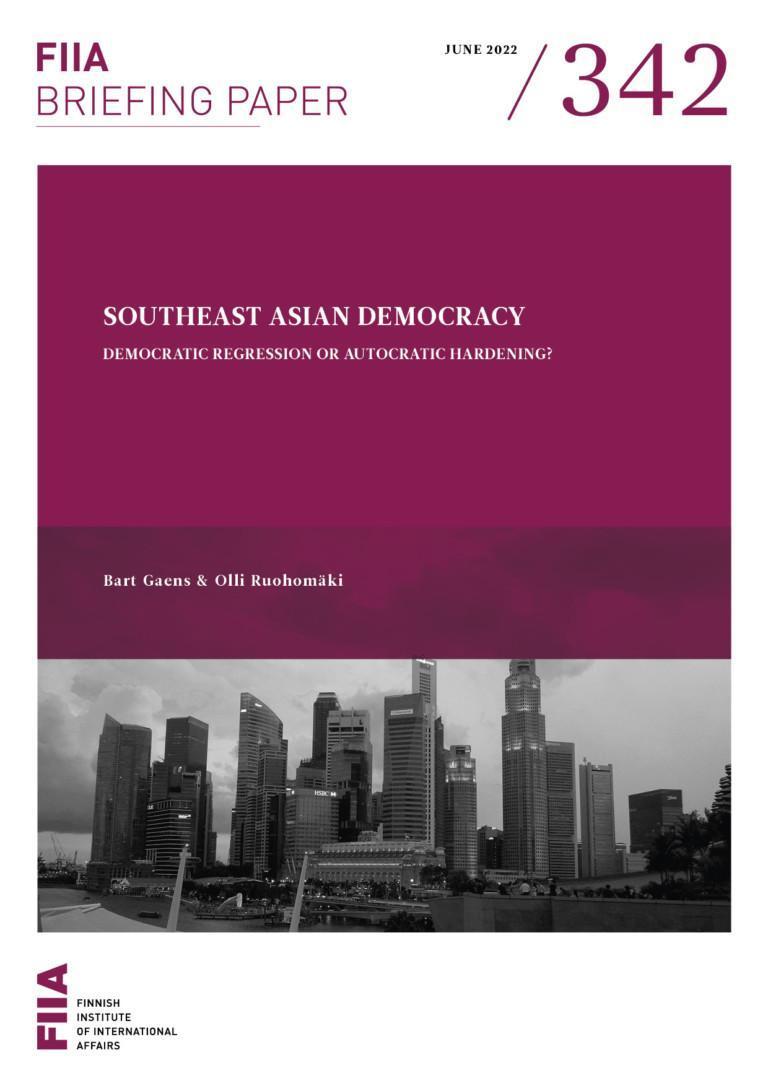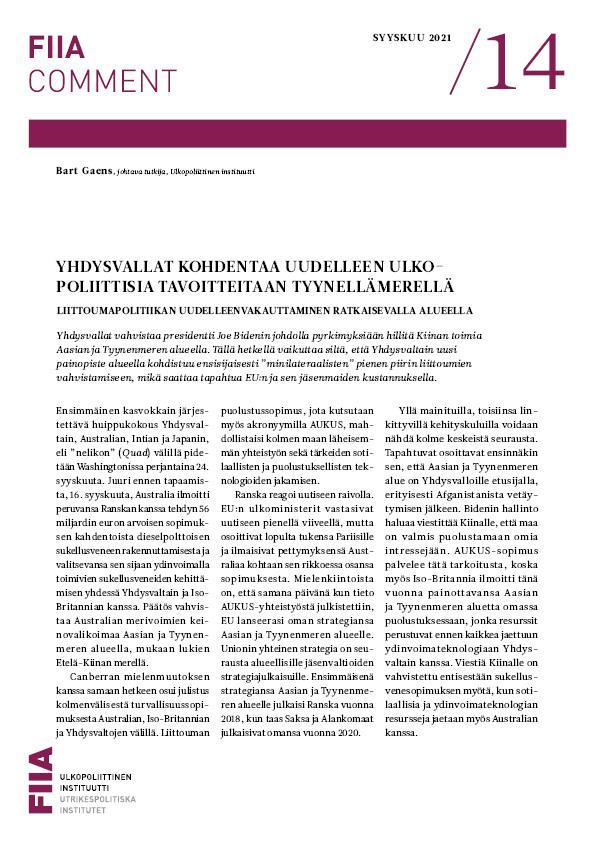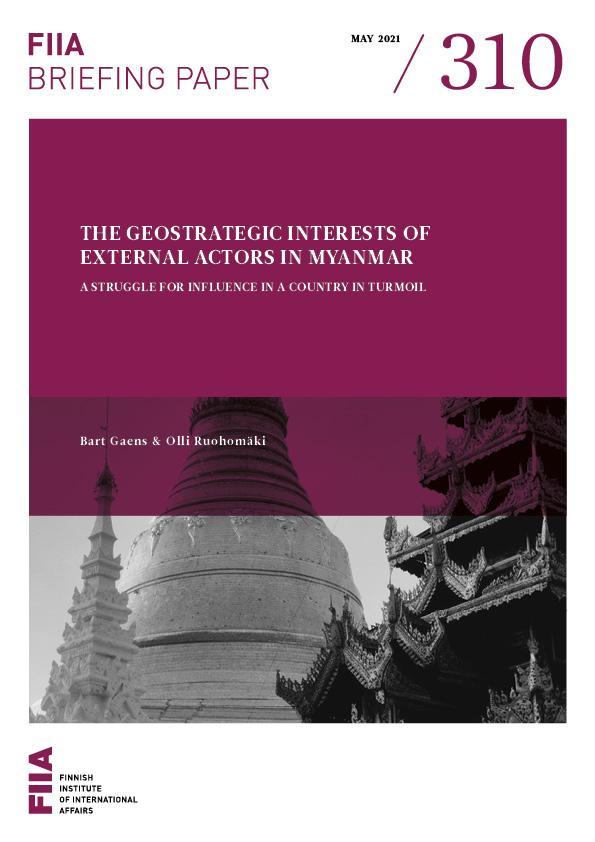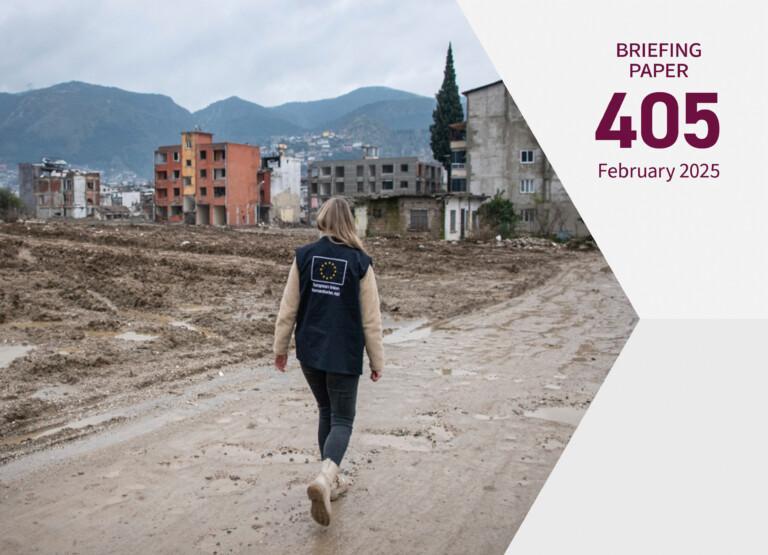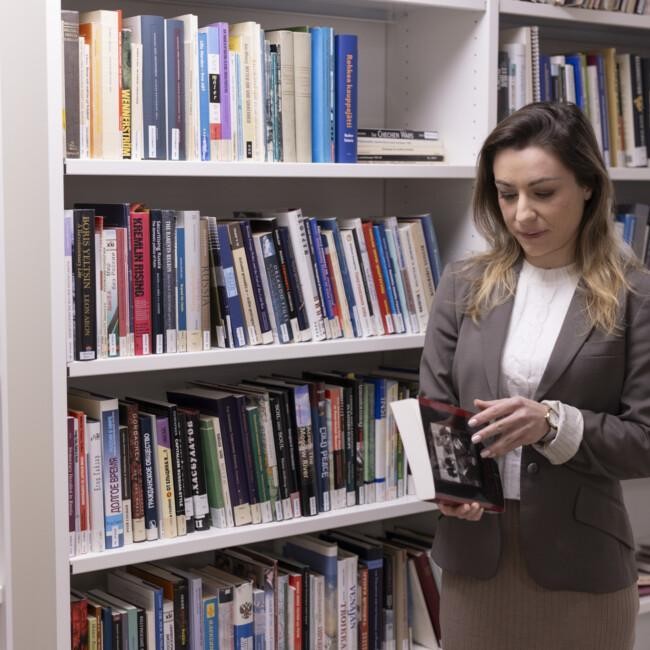
Globaalin kehityssuunnan mukaisesti demokratia on heikkenemässä Kaakkois-Aasiassa. Ilmiöstä herää kysymys, onko demokratiakehitys alueella tullut tiensä päähän.
Suurin osa Kaakkois-Aasian maiden yhteistyöjärjestö ASEANin jäsenmaista ei ole kokenut demokratisoitumisen aaltoa pitkän autoritäärisen ajanjakson jälkeen. Sen sijaan alueelle ovat olleet ominaisia huomattavan resilientit ”puolidemokratiat” ja suhteellisen vakaat itsevaltaiset hallinnot, joissakin tapauksissa vahvasta talouskasvusta ja yhteiskunnallisesta kehityksestä huolimatta. Demokratia, tai ennemminkin joillain demokraattisilla elementeillä höystetty autokratia, on ollut vuoroin nousussa ja vuoroin laskussa.
Suurin osa Kaakkois-Aasian ”puolidemokratioista” ja autokratioista suojautuu riskeiltä harjoittamalla tasapainoilupolitikkaa, eli ne tekevät yhteistyötä useiden kumppaneiden kanssa. Joukossa on Kiina, joka ei ole kiinnostunut kumppanimaidensa poliittisista järjestelmistä, mutta myös Yhdysvallat, EU ja Japani.
Pragmatismi on luontainen osa ASEAN-maiden hallintojärjestelmien toimintatapaa. Niin kauan kuin elinolot paranevat tai vähintään pysyvät vakaina, osallistavaa politiikkaa ja ihmisoikeuksia yhteiskunnan kehityksen keskiössä pitävään länsimaiseen demokratiaan ei juuri kohdistu kiinnostusta.
Introduction
The election held in the Philippines on 9 May 2022 was won by Ferdinand “Bongbong” Marcos, son of the elder Ferdinand Marcos who ruled the country with a strong hand for over two decades starting in 1965. Ferdinand Marcos Jr. is expected to seek to restore his family’s power position, after his father was ousted by the People Power Revolution (EDSA) uprising in 1986. The incumbent President Rodrigo Duterte was legally prevented from seeking re-election, but his daughter successfully ran for vice-president along with Marcos.
For many, the return of the Marcos family denotes a staunch reminder of the kleptocracy and dictatorial rule of over two decades under Ferdinand Marcos Sr. Following Duterte’s rule, which was marked by efforts to weaken democratic judiciary institutions and included ruthless extrajudicial killings of drug dealers, many fear this could mean a further backsliding of democracy in the Philippines.
Numerous countries in Southeast Asia face an overall decline in levels of democracy, in line with a global trend. This may raise the question of whether democratic progress in Southeast Asia has reached its limits, particularly at a time of great-power competition between authoritarian China, which is not interested in the political systems of the countries it deals with, and the US, which has undergone its own process of democratic backsliding in recent years. This Briefing Paper aims to address that question by first introducing the general state of play in Southeast Asian democracies, before providing a country-by-country analysis and taking a glance at the geopolitics of external actors in Southeast Asia.
State of play of Southeast Asian democracy
Democracy in Southeast Asia has made progress in the twenty-first century, but most countries have displayed remarkable authoritarian resilience. They remain flawed democracies at best in a region rife with corruption, elitist rule, poverty and human rights breaches. In ASEAN, democratization has been marked by elite-managed transitions to a new form of politics rooted in formally democratic institutions dominated by wealthy oligarchic elites.[1]
But the modest progress towards democratization in some Southeast Asian countries has also been in decline. This trend is a global one. The level of democracy is down to 1989 levels, autocratic regimes house 70% of the global population, while the world, including the EU, is witnessing a rise in autocratizing countries.[2] The Russian invasion of Ukraine can be seen as a harrowing culmination of this process.
Southeast Asia is a hugely diverse region, and the political landscape reflects that diversity, showing substantial variation in the levels and types of regimes, economic development, state capacity and historical legacies. There are different ways of categorizing political systems, but a salient way of looking at the issue is through the V-DEM 2022 Report on Democracy, which groups countries into democratizers and autocratizers.[3] All Southeast Asian countries except for Indonesia, which is categorized as an electoral democracy, are grouped in the bottom 50% of V-DEM’s liberal democracy index. Accordingly, in 2021 Thailand, Cambodia and the Philippines have autocratized, Malaysia has slightly democratized, while the rest have not experienced significant change, save for Myanmar, which went through a bloody coup d’état.
While it is impossible to label the whole of Southeast Asia using one all-encompassing term, it is possible to discern the main trajectory that the region is heading towards. The region is experiencing an overall democratic regression or, to put it another way, an autocratic hardening. Most countries are hovering somewhere between electoral autocracies and closed autocracies. It is worth noting that most authoritarians have become more sophisticated in their strategies to maintain and consolidate power. Gone are the days of brutal oppression, save again for Myanmar, which is the exception to the rule.
ASEAN’s flawed democracies: Indonesia, Singapore, Malaysia and the Philippines
Indonesia
As the region’s largest country with over 270 million people, Indonesia had an authoritarian regime for 31 years under President Suharto (1967-1998). Suharto’s “controlled democracy” focused on a strong, nominally-civilian regime with a heavy military component, and on development and economic growth. Indonesia started democratizing after a popular uprising during the Asian financial crisis of 1997-1998 forced authoritarian Suharto to step down.
Starting in 1998, Indonesian democracy made great strides. In the wake of the ruthless occupation of East Timor that ended in 1999 and the settlement of the Aceh insurgency in 2005, President Yudhoyono established civilian control over the army. He set in motion an ambition plan of economic reform and infrastructure development that only partly succeeded, but substantial reforms breaking the monopoly of oligarchs and improving civil society participation did not materialize as quickly as anticipated.[4] This may have contributed to the rise to power of Jakarta governor Joko Widodo (Jokowi). Jokowi’s plans for democratization ran into a roadblock in 2014 when the parliament ended direct elections for local offices, paving the way for elite control and local powerbrokers.[5] Jokowi, whose second and final term in office ends in 2024, was seen as a reformer when he was elected in 2014, but hopes for more democracy have dwindled, with political dynasties gaining in prominence, corruption increasing and civil liberties decreasing. Furthermore, during his administration, the military have taken on a much more prominent role in politics.
Singapore
A city-state of nearly 5.7 million people, Singapore thrives due to its financial sector and logistics hub in the Strait of Malacca. It is the only state in the region that has achieved the status of a high-income economy. The ruling People’s Action Party (PAP), in power since 1959, delivers on economic growth and social programmes, forming a stable type of “flawed democracy”. Singapore is criticized for limiting freedom of expression and placing restrictions on media and educational institutes. The PAP is genuinely popular, however, even if the party’s success is often linked with “gerrymandering”, or the high disproportionality between votes received and seats obtained, heavily favouring the PAP.
Malaysia
Malaysia long had a one-party rule, until the 2018 election brought a reformist government to power. The reign of Mahathir Mohamad from 1980 to 2003 included strict security laws that curtailed civil liberties and judicial independence. In 2009, Prime Minister Najib Razak democratized national elections, but faced criticism when he cracked down on activists and demonstrators, and was accused of corruption. Malaysia is also criticized for failing to protect religious minorities. After making initial progress, the reformist government collapsed and was replaced by an all Malay-Islamic coalition in 2021, including parties that were at the core of the pre-2018 regime, denoting a clear democratic backsliding.
The Philippines
The Philippines is an interesting case in that the transitioning government following the EDSA uprising resulted in power being handed back to the old elite that were displaced by the deposed dictators. The government of Corazon Aquino was unable to implement economic reform, including wealth redistribution, giving space instead to the political dynasties and oligarchs that her predecessor Marcos sought to displace.[6] This “backsliding” is similar to the case of Indonesia, noted above.
In sum, democracy in all four countries remains flawed and, despite significant democratic gains in some, none of these countries have progressed to the point that they could serve as a model for democratization in Southeast Asia.
Variants of autocratic leadership in Cambodia, Thailand, Vietnam and Laos
On the face of it, placing Cambodia, Thailand, Vietnam and Laos in the same category of autocracies may appear somewhat odd. After all, their political systems do differ. Closed autocracies Vietnam and Laos are the last bastions of communist one-party rule in the region, Thailand is a constitutional monarchy that has become a closed autocracy, and Cambodia is an electoral autocracy. Yet, scratching the surface, all of these countries have many commonalities. They all display autocratic features and their elections are marred by repression, candidate restrictions and fraud to the point that there is little uncertainty in their outcome. Space for civil society activism and media freedom is limited. There are, of course, differences in the degrees of suppression of dissenting voices, ranging from the outright use of violence to silence opponents to more sophisticated measures, such as the use of fraudulent court rulings to ban the work of political activists.
Cambodia
Cambodia has gone through numerous elections since the 1991 Paris Peace Agreement that marked the end of the Cambodian-Vietnamese War and the Third Indo-China War. However, there has been much debate on whether or not the regularly held elections have ever been truly free and fair. In recent years, the space for free political debate has shrunk considerably as the Cambodian People’s Party (CPP), led by strongman and former Khmer Rouge soldier Hun Sen, has consolidated its power. In fact, Cambodia has recently witnessed a systematic crackdown on press freedoms and an assault on civil society and dissenting voices. Throughout the decades, Hun Sen has promoted the notions of stability, growth and prosperity above human rights and democracy.
It is true that Cambodia has witnessed rapid economic growth in the past decade. Besides agriculture, a growing garment industry and tourism have been the drivers of economic development, and the country has risen from the ashes of civil war. On top of this, Cambodia has managed to attract major Chinese investments and is now an integral part of China’s Belt and Road Initiative (BRI) in Southeast Asia. Furthermore, Hun Sen has used the close Cambodian-Chinese relations to exercise leverage in the strategic competition amongst regional neighbours and external actors interested in Southeast Asia.[7] Hun Sen and his CPP have emerged as the authoritarian hegemons in the Cambodian polity and there is little prospect in the near future for their opponents to challenge their power in a way that would bring about change in the political landscape of the country.
Thailand
Thailand’s current government came to power following a coup in 2014, resulting in a serious democracy deficit. The Thai military has managed to build a political system that has been referred to as a military-dominated pseudo-democracy.[8] The Thai model allows for a strong central government dominated by the military, which “guides” democracy by suppressing opposition voices with lèse-majesté charges and a constitution that allows the military to have a decisive say in Thailand’s Senate, Election Commission and Constitutional Court. The Thai military wield significant economic and social power and the civil-military relations have been fraught with tension. The result has often been a coup by the military leaders, who have been unhappy with civilian governments seeking more control over the military. In fact, there have been 18 coups in Thailand since 1932 when the country became a constitutional monarchy. Thailand’s polity remains deeply divided and the military have established themselves as the authoritarian hegemons.
Vietnam and Laos
Vietnam and Laos are one-party states, where the communist parties’ grip on power remains solid. There is no meaningful space for political opposition. The communist parties lay claim to legitimacy through “strategic guidance” with regard to the developmental direction that the countries are to take. This is especially true in terms of economic development as Vietnam has become one of the rapidly developing Southeast Asian tigers. Popular participation, particularly in the Vietnamese case, is directed towards establishing administrative pathways to manage citizen complaints and feedback regarding social and economic agendas at the local level. The focus is on holding public officials to account and curbing corruption. This is a form of political participation that is not so much about the expression of differing political opinions, but rather a way of containing political conflict by channelling it through tightly controlled state institutions.[9]
From the perspective of curbing corruption, this strategy has borne fruit as Vietnam has moved in a positive direction, as measured by Transparency International’s Corruption Perception Index. In 2021, Vietnam ranked 87/180 whereas in 2011 it was ranked 112/184. Despite advances in good governance, concepts such as the separation of powers or civil society are still considered taboo to the government. Any debate around the notions of democracy and freedom of expression are highly sensitive and the Communist Party of Vietnam worries that such debates will lead to political pluralism that will threaten the stability of the country, and hence the power of the authoritarian communist party that remains the hegemon in the Vietnamese polity.
Myanmar into the abyss
After staging a coup on 1 February 2021 and declaring a year-long state of emergency, Myanmar’s military (the Tatmadaw) installed a military-run State Administration Council (SAC), and promised future elections in order to establish a “genuine and disciplined democratic system” as part of a five-point roadmap. Over a year has passed and Myanmar is in free fall. Just a few years ago, Myanmar was considered a success story in terms political pluralism and openness in Southeast Asia, particularly given the decades of isolation that it was emerging from. This, however, turned out to be a false dawn. The military is firmly back in power, and the country is engulfed in violent conflict between the army and the numerous ethnic armed organizations that also have internal squabbles. Close to a million Rohingya, Myanmar’s stateless Muslim minority, have fled to Bangladesh and other neighbouring countries. Aung San Suu Kyi, the leader of the former civilian government, is currently in jail. In addition, over 300 local anti-military militias called People’s Defense Forces (PDFs) have emerged on the scene, bringing yet more violence to an already complicated political situation.
During the spring of 2022, a more encompassing political platform termed the National Unity Consultative Council (NUCC) emerged. In essence, the NUCC has representatives from all the actors that oppose the Tatmadaw. It posits itself as a counterforce that attempts to unite all the groups that wish to put Myanmar back on the democratic track. Nevertheless, the prospects of the Tatmadaw and the NUCC coming to an agreement on a transition back to the time before the coup appear highly unlikely. On the contrary, Myanmar’s polity is highly polarized and the ongoing violence throughout the country does not show any signs of subsiding.
External actors and geopolitics
The overall picture brings the role of external actors to the fore. 2022 marks the 45th anniversary of EU-ASEAN relations, which will be celebrated at a summit later this year. The EU has strongly supported regionalism and democracy promotion in Southeast Asia, providing assistance for the drafting of the ASEAN Charter in 2006 and 2007, and for the creation of the ASEAN Intergovernmental Commission on Human Rights (AICHR). Both institutions can be seen as examples of a “democratic turn” within ASEAN, even if, in line with ASEAN’s emphasis on informality, both the Charter and the human rights body lack the power to prevent political upheavals or protect human rights. Instead, the ASEAN Way, including a heavy emphasis on national sovereignty and a commitment to non-intervention in the affairs of member countries remains paramount, preventing a supranational response to internal crises such as the plight of the Rohingya in Myanmar. Adherence to non-interference also prevents pressure for democratization or criticism of regime change in other ASEAN members.
Japan, a key player and major investor in Southeast Asia, has traditionally kept a low profile when it comes to democracy assistance, but has provided development aid to governments willing to democratize. However, partly due to its own history, Japan has been relatively reluctant to interfere in the internal affairs of recipient countries, and has de facto adhered to a non-conditionality policy. Instead, Japan’s economic cooperation has been firmly focused on the promotion of its own national interests, commercial as well as strategic.
The ongoing great-power competition between China and the US, including in Southeast Asia, has pushed human rights and pressure to adhere to democratic norms onto the back burner, trading them for a more pragmatic foreign policy and giving precedence to economic interests. Furthermore, the overall “democratic rollback”, as Freedom House has labelled it, including in the US and elsewhere, has led ASEAN states to be even more hesitant to accept external criticism. In addition, the decline of democracy in the West has arguably made “Western-style” democracy even less appealing to Southeast Asian countries, lending credence to the idea of Western countries’ double standards instead.
This plays into China’s hands. China is rapidly ascending as an assertive power in Southeast Asia, while the US influence in the region is in relative decline. Many autocratic leaders in the region feel the “pull” from Beijing in their polities, as China is a major investor and a significant market for the region’s economies. Southeast Asian autocratic leaders also appreciate the fact that China does not preach democratic values or raise human rights concerns in its dealings. It is therefore little wonder that many of the region’s autocrats look up to the Chinese premier Xi Jinping as a model of strongman leadership in order to buttress their own hold on power.
Even so, it needs to be kept in mind that many Southeast Asian nations are engaged in the politics of hedging. In other words, while autocrats consolidate their grip on power, they do not completely rely on one major external power such as China. They do cooperate and seek relations and partnerships with the US, the EU and Japan. It is an insurance policy against failure and also a way of staying in power. For example, many Southeast Asian countries adeptly utilize the intense competition between China and Japan in the field of connectivity and infrastructure investment. The Philippines, for example, has numerous infrastructure deals with China under Duterte’s “Build Build Build” programme, while Japan remains a top investor in the country.
Conclusion
The case of Southeast Asia confirms that liberalization processes are not attempts to transition to democracy, but a means to co-opt internal and external opposition and build legitimacy with the public.[10] However, it is worth stressing that just because the leadership in most Southeast Asian states have leanings towards autocratic ways of governing, this does not mean that the rest of society accepts autocracy in its different hues as a mode of governance. On the contrary, most nations, apart from the outright one-party states, have vibrant civil societies that act as counterforces to the political leadership, call for open debate and have a yearning for political participation in decision-making. The region has witnessed many social movements calling for change, with counter-movements backing up the autocrats in power.
As argued in this Briefing Paper, most Southeast Asian states have not undergone a “wave of democratization” such as those in Eastern Europe and Latin America, following a long period of authoritarianism and suppression. Instead of a linear trajectory from closed to open political systems, democracy, or rather autocracy with some democratic elements, has been ebbing and flowing. The region sees remarkably resilient “flawed” democracies and relatively stable autocratic regimes, in some cases in spite of strong economic growth and social development. Singapore is a prime example of this. The ruling party has retained its mandate largely because economic and social conditions have consistently improved since independence. Pragmatism, therefore, is inherent in the way that ASEAN polities are managed. As long as living conditions improve, or at least remain stable, there is little appetite for Western-style democracy and its emphasis on participatory politics and human rights being at the heart of societal development.
Endnotes
[1] Jones, Lee. “Democratization and foreign policy in Southeast Asia: the case of the ASEAN Inter-Parliamentary Myanmar Caucus.” Cambridge Review of International Affairs 22.3 (2009): 387-406.
[2] V-DEM Institute. Democracy Report 2022: Autocratization Changing Nature? V-Dem Institute at the University of Gothenburg, 2022, pp. 6-7. https://v-dem.net/media/publications/dr_2022.pdf. The trend of democratic decline, exacerbated by the pandemic, is confirmed by other observers such as Freedom House and the Economist Intelligence Unit.
[3] Ibid. V-dem distinguishes between liberal democracies, electoral democracies, electoral autocracies, and closed autocracies.
[4] Arugay, Aries A. and Sinpeng, Aim. “Varieties of authoritarianism and the limits of democracy in Southeast Asia.” Contemporary Southeast Asia: The politics of change, contestation, and adaptation (2018): 91-109, p. 91.
[5] Austin, Michael R. The End of the Asian Century. War, Stagnation, and the Risks to the World’s Most dynamic Region. New Haven and London: Yale University Press, 2017, p. 108.
[6] Arugay and Sinpeng 2018, p. 99.
[7] Loughlin, Neil. “Chinese linkage, leverage, and Cambodia’s transition to hegemonic authoritarianism.” Democratization, Vol 28, Issue 4, 2021, pp. 840-857.
[8] Chambers, Paul. “Commentary: Thailand as a model? Why Myanmar may follow Prayuth’s example.” Channel News Asia, 7 April, 2021. https://www.channelnewsasia.com/news/commentary/myanmar-coup-thailand-prawit-military-political-system-lessons-14560352.
[9] Rodan, Garry. Participation without Democracy: Containing conflict in Southeast Asia. Ithaca: Cornell University Press, 2018.
[10] Arugay and Sinpeng 2018, p. 103.


